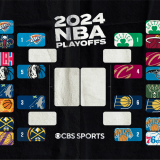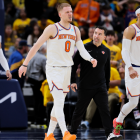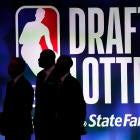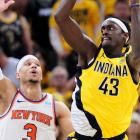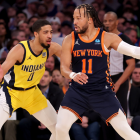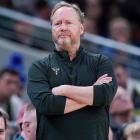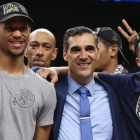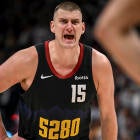The NBA's transition to its modern form -- perimeter focused, 3-point, efficiency and versatility dependent -- was not subtle. What we see now not happen slowly, though there were signs along the way. Wilt Chamberlain was the dominant center who decided he would lead the league in assists, and did so in 1967-68. Magic Johnson's Showtime Lakers blazed a trail with a blend of transition basketball and athleticism. Don Nelson's Golden State Warriors threw pace into an accelerator and Mike D'Antoni's Seven Seconds or Less took that to a new level. George Karl bent the ideas of position, and Stan Van Gundy's Orlando Magic -- behind Rashard Lewis as a stretch four and Hedo Turkoglu as a point forward -- raided the East when it was thought that only LeBron James or the Big-3 Celtics could rule.
But still, the word "tweener" was used to describe a forward too small for his positions four years ago. Only two years ago, big men remained in high demand because coaches valued their strength and post scoring.
Discussions often turn to how today's stars would fare back in the day, as former players often posit that today's All-Star would fail. We also talk about how some modern players, like Al Jefferson or a number of centers and shooting-challenged wings would have fared better in the past. But are there players from previous eras who would have been at home in today's game? Here are 10 forwards -- including some all-time greats -- from yesteryear whose skills and abilities were ahead of their time, and who would have thrived in today's NBA (probably even more).
Kevin Garnett
Garnett won an MVP, an NBA title and is a future Hall of Famer. It's crazy to think he could be better today, but look at his game during his absolute prime (2000-05). He averaged more than 20 points, 11 rebounds and five assists over that span. He's tied with Tim Duncan for the most seasons in NBA history with 30 points, 10 rebounds, five assists and two blocks per 100 possessions. Garnett did this all while putting in Defensive Player of the Year-worthy seasons.
K.G. was a monster, and while he would be productive in any era, his versatility is most noteworthy. Garnett was as mobile as any player during a time where mobility wasn't as valued as today. In today's NBA, Garnett as a small-ball five would be a destroyer of worlds. He would be a better version of Draymond Green. Go to the 1:39 mark and watch him pass off the screen and roll:
Teams switch more on pick and rolls than ever, and Garnett would be one of the few players who could effectively switch 1-5 and never have a mismatch. He could contain Russell Westbrook, smother Stephen Curry, challenge LeBron James, stymie Giannis Antetokounmpo and battle DeAndre Jordan.
Garnett shot better than 35 percent from deep in only one season, in 2000 at age 23. But the game was not geared to that element for another seven or eight seasons -- and especially not for big men. These days, you can bet The Big Ticket would be working tirelessly on it, and it's very possible he would become a consistent 3-point shooter.
Chris Webber
C-Webb made the first round of candidates for the Hall of Fame this year but fell short of the cut. That would not have happened if today's NBA time traveled back to the early 2000s, when Webber was one of the game's most dynamic power forwards. His game was tailor-made for the modern NBA.
Like K.G., the building blocks for a more modern game were evident when Webber was younger. In 1996 with the then-Bullets, Webber averaged 2.3 3-point attempts, knocking down 44 percent of them. As time went on, that number increased to 2.9 attempts in his final year in Washington (1998) before vanishing in Sacramento. Had that part of his game been nourished, Webber would have combined the size of Green with the shooting of Ryan Anderson and the finishing capability of Serge Ibaka.
Oh, and he could pass, too. Check out the play at 4:37 below. Webber helps on the perimeter, creates a steal, runs the floor, gets an offensive rebound in traffic and slings a pass for a 3-pointer:
Webber played best passing teams of all time in Sacramento. Feast your eyes on these plays with Jason Williams, particularly the pass at 1:02 and the play at 4:30 where Webber pump-fakes the 3-pointer, kicks to the perimeter then cuts to the rim for a dunk:
Webber could have played stretch four or small-ball five, and would have ruined worlds with his versatility. Imagine if Markieff Morris was way better.
The other key here is that Webber had microfracture surgery in his prime at age 29 in 2003, causing him to miss most of the 2004 season. He was never the same. Microfracture surgery was pretty standard for serious knee injuries and the outcomes -- especially long-term -- were always poor (Amar'e Stoudemire, Penny Hardaway and Jamal Mashburn saw their careers limited by the same procedure).
Webber's combination of size, athleticism and skill would have made him invaluable in today's NBA, especially if he had committed to 3-point shooting. Put it this way: If Webber were to sign with the Rockets, we'd be talking about Houston as a real challenger for Golden State.
Larry Bird
Maybe no player suffers more from the past resistance to adapting the 3-point shot than Larry Legend. The most 3-pointers Bird ever attempted in an NBA season was 237 in 1988. Last season, 112 players attempted more, and six made more. The 3-point shot was mostly a desperation play. And so Bird, inarguably one of the greatest shooters to ever step on hardwood, is overlooked because he simply didn't take them. And yet, when he did ...
Bird had six seasons where he shot better than 40 percent from deep. Yet his highest season in 3-point rate (1990-91) saw him with only 19.5 percent rate of his shots from deep. By comparison, Brook Lopez had a 3-point rate of 33 percent last season (though it should be noted that Jimmy Butler had a 19.8 percent 3-point rate). In 1984-85, Bird finished second in scoring to Michael Jordan by 18 points, despite shooting only 7 percent of his shots from deep. Imagine if he'd taken only 20 percent of his shots from deep.
Bird was also an incredible passer:
Put Bird in the modern NBA with above-the-rim finishers for alley-oops, more movement off-ball and using him as the screen man more? Bird as a stretch four is absolutely terrifying. It would be combining the passing of Nikola Jokic and shooting of Klay Thompson in a 6-foot-9 frame. Bird was one of the best ever, but underutilized when considering how the game is played today.
It's not all roses, though. Bird may have struggled with defending today's athleticism, especially if more modern procedures were unable to ease his back issues. Bird would have found taller, more athletic personnel attached to him, and without an especially dynamic handle, running pick and roll to clear space may have been difficult. Even so, it's hard to believe Larry Legend wouldn't have found a way to adapt and thrive.
Grant Hill
He didn't shoot 3s at his peak, so we're left to wonder whether one of the most dynamic players of the past 30 years would have adapted. But when we see shot 44 percent (!) from deep in 2010 for Phoenix, there's pretty good evidence he would.
Meanwhile, watch everything he did in this matchup with Shaquille O'Neal and Kobe Bryant -- especially the passes:
Hill may be a borderline case. Would his game have evolved in the modern NBA? He was very much a product of the Jordan era, which is why he was so often compared to his Airness, more than any other player when he entered the league -- including Kobe, for whom the comparisons came later. Hill's game was mid-range heavy, low on 3s and limited in approach. He was a half-court player, though an excellent one.
His role in a modern context is what's interesting to think about. By comparison, Green is listed at 6-7, 230 pounds. Hill was 6-8, 225 -- taller than Green and 5 pounds lighter. Could he have played small-ball four? Five? Does Hill take on more of a point-forward role, a la LeBron in today's league? Did he have the vision?
Maybe the biggest reason Hill would benefit from today's game, though, is medical science. Rest, injury prevention and control, biometrics, strength and conditioning -- all of these things may have drastically changed his trajectory.
Jamal Mashburn
He would have been incredible in today's game. The 6-8, 240 (10 pounds heavier than Green) Mashburn would have absolutely destroyed in small-ball units.
Mashburn had the size to set effective screens, the versatility and range to hit deep shots, and the feel to move the ball effectively. Check out the pass at 3:40, and the off-ball screen fake to the pop at 4:58:
Mashburn would have adopted the Dirk Nowitzki one-legged step-back as Anderson has, and his athleticism on switches defensively would have been so effective. Throw Mashburn on the Spurs in place of LaMarcus Aldridge and San Antonio is considerably better.
Mashburn's numbers in 2000 compare favorably with Blake Griffin, James and Giannis Antetokounmpo last season. Part of why Mashburn would be so much better today is the way guys of his size are used. He'd be setting screens and delivering the ball to guards on dribble hand-off plays, then rolling to the rim, or popping. He'd be spotting up in transition from deep, and then slicing to the rim for jams when defenders closed out. Like Hill, his injury issues would have been somewhat alleviated by improved medical procedures.
Shawn Marion
This one is tricky. Even on the Seven Seconds or Less Suns, Marion never recorded more than 2.7 assists per game. But he was always used as the tip of the spear in Phoenix, with Steve Nash handling the ball all the time.
But The Matrix is one of only 12 players in NBA history with 15,000 points, 10,000 rebounds, 2,000 assists and 1,200 blocks in their careers (the other 11 are Hall of Famers or absolute locks -- Marion deserves entry).
His versatility was key, but if you want the real reason he'd be great in today's NBA, it's his defense. It helped the Mavericks win the title in 2011, but still isn't viewed to be as strong as it was:
Marion's shooting outside of Phoenix was poor; he shot better than 33 percent from deep only once when not with the Suns. But even before Nash arrived, he showed an aptitude from beyond the arc -- despite his bizarre motion. With a modern emphasis on it, there likely would have been improvement.
Marion's defense was overlooked because it was never a point of emphasis in Phoenix, but the Suns were never below 18th in defense and were top 15 several times between 2004 and 2008, in large part because of Marion. He struggled to fit with more traditional teams in Miami and Toronto, before finding his place in Dallas.
Marion would be an exceptional cog in today's NBA precisely because he never needed the ball to be effective.
Toni Kukoc
You know what we call 6-10 Euro forwards who can shoot, pass, and drive in today's NBA? Unicorns. In '95, we called him "the guy Michael Jordan hated because Jerry Krause liked him so much and everyone thought he was soft."
Kukoc was well ahead of his time, and that mix-tape proves it. His anticipation of making the right play to the cutter, the ability to shoot from range, the mobility for a guy his size, all were overlooked as not being as useful as raw size and individual scoring ability back then.
Kukoc shot better than 40 percent from deep in 1995-96, on only 2.7 attempts per game. You put him in a modern context and he would slice teams to pieces. Kukoc was a combination of Michael Beasley, Danilo Gallinari and Kevin Love, but often dismissed because of Jordan's dominance. Additionally, these days teams would be way more aggressive in getting him to come over from Croatia. International scouting has come such a long way. Kukoc would not last until the second round as he did in 1990.
Lamar Odom
In many way, Odom was a precursor. He just missed the position revolution, and his effectiveness was limited by playing in the Triangle. He was still great -- what he did for those Lakers teams directly led to two championships. But Odom would have been capable of a great deal more today, because his versatility and athleticism would have been more valuable, even if he was a "space cadet" as he was sometimes called.
Odom in a pick and roll could be devastating, passing off the short roll, and in 2010-11, the year before he was traded to Dallas and his personal life fell apart, Odom shot 38 percent from deep. Odom would be used entirely differently today, and he was rarely on teams that pushed the pace. He wouldn't have been a No. 1 in today's NBA (as neither would many of the players on this list) but he would have been exceptional next to any number of guards. Imagine a modern Odom on OKC next to Russell Westbrook and Paul George, or in Portland with Damian Lillard.
Clifford Robinson
At 6-10, Robinson shot better than 36 percent from deep in six NBA seasons, including 42 percent in 1998-99. Watching him, he was like the beta version of Durant before the developers turned all the skill sliders up.
"Uncle Cliffy" would have been used entirely differently in today's NBA, and his mobility and wingspan would have made him significantly more impactful defensively.
Chuck Person
It's not hard to see that "The Rifleman" would have excelled in today's game. Able to play anywhere between the two to a small-ball four, Person's combination of skill and range would have been mighty useful.
Person would be insane on the Rockets, or spotting up for Westbrook in OKC.
Honorable mentions: Gerald Wallace, Josh Smith, Dale Ellis, Detlef Shcrempf







